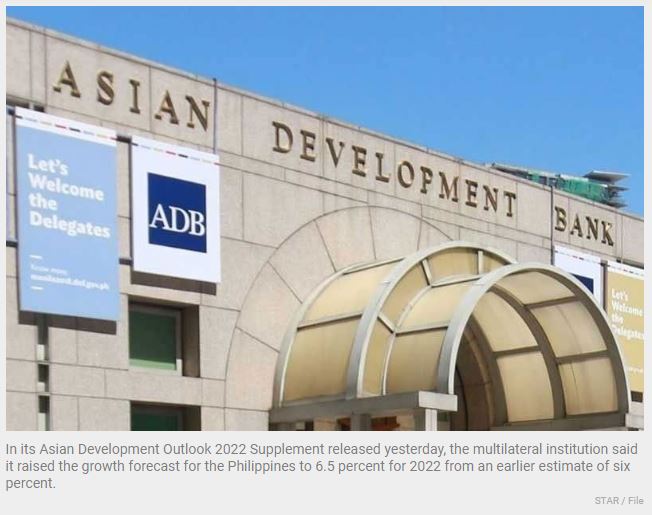ADB hikes Philippines growth forecast GDP seen to grow by 6.5% this year
MANILA, Philippines — The Asian Development Bank (ADB) expects the Philippine economy to grow faster than initially anticipated this year, following the stronger-than-expected performance in the first quarter with the easing of pandemic-induced restrictions.
In its Asian Development Outlook 2022 Supplement released yesterday, the multilateral institution said it raised the growth forecast for the Philippines to 6.5 percent for 2022 from an earlier estimate of six percent.
The ADB’s new forecast is at the lower end of the government’s revised 6.5 percent to 7.5 percent gross domestic product (GDP) growth target for the year.
In adjusting its forecast upwards, ADB cited the 8.3 percent economic growth seen in the first quarter, which was supported by a rebound in investment and household consumption.
It said the wider coverage of COVID-19 vaccination and relatively mild health impacts from the Omicron health variant have enabled further reopening of the economy.
As a result, many businesses have resumed operations and mobility across several activities are back to pre-pandemic levels.
“The Philippine economy’s growth momentum has accelerated close to its ideal growth path,” ADB Philippines country director Kelly Bird said.
“Strong domestic demand supported by a pick-up in employment and remittance inflows, private investment expansion, and large public infrastructure projects will underpin the country’s recovery from the economic impact of the pandemic,” he said.
ADB expects the government to continue to spend on priority infrastructure projects under the Build Build Build program to support growth.
Among the government’s priority infrastructure projects with ADB funding are the Malolos-Clark Railway Project and South Commuter Railway Project, both part of the North-South Commuter Railway System to link Metro Manila to the northern and southern Luzon provinces.
Other projects with ADB financing are the EDSA Greenways Project, which aims to improve the pedestrian environment along EDSA, and the Metro Manila Bridges Project being implemented to help ease congestion.
Downside risks to the country’s growth seen in the second half of the year are the slowdown in economic activity in major advanced economies and a likely scenario of commodity prices staying elevated due to the war in Ukraine.
For next year, the ADB maintained its economic growth forecast for the Philippines at 6.3 percent “as financial tightening and a broader pass-through of price pressures weigh on demand.”
For Southeast Asia, the regional lender upgraded its GDP growth forecast to five percent for this year from an earlier estimate of 4.9 percent, on the back of strong consumption growth in the first five months of the year with the gradual lifting of restrictions and reopening of borders.
Meanwhile, the ADB retained its 5.2 percent economic growth outlook for Southeast Asia for next year.
It said both manufacturing and services output are increasing in most Southeast Asian economies, leading to the creation of jobs and higher household incomes.
Southeast Asian economies, however, are facing challenges in terms of higher oil prices and interest rates, as well as trade and supply disruptions.
When it comes to inflation forecasts for the country this year and next year, these were also adjusted to take into account the higher global commodity prices and the depreciating local currency.
ADB now expects inflation in the country to reach 4.9 percent this year, up from the previous forecast of 4.2 percent.
The bank’s forecast for the country’s inflation rate next year is now at 4.3 percent from 3.5 percent previously.
The country’s average inflation rate for the first half was at 4.4 percent, higher than the Bangko Sentral ng Pilipinas’ two to four percent target range.
For Southeast Asia, the bank hiked its inflation forecast for this year to 4.7 percent from its earlier estimate of 3.7 percent.
It also raised its inflation forecast for Southeast Asia next year to 3.4 percent from 3.1 percent.
Higher inflation rates are seen in the region for this year and next year due to rising energy and food prices as well as supply chain disruptions.
Source: https://www.philstar.com/business/2022/07/22/2197060/adb-hikes-philippines-growth-forecast-gdp-seen-grow-65-year


 English
English




